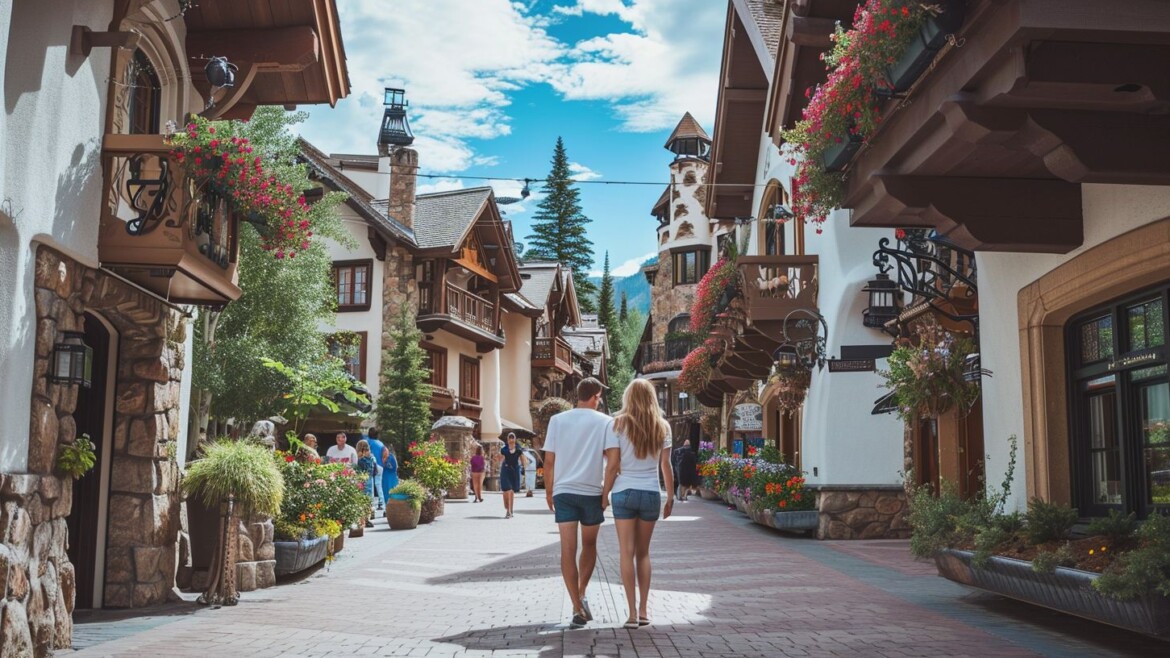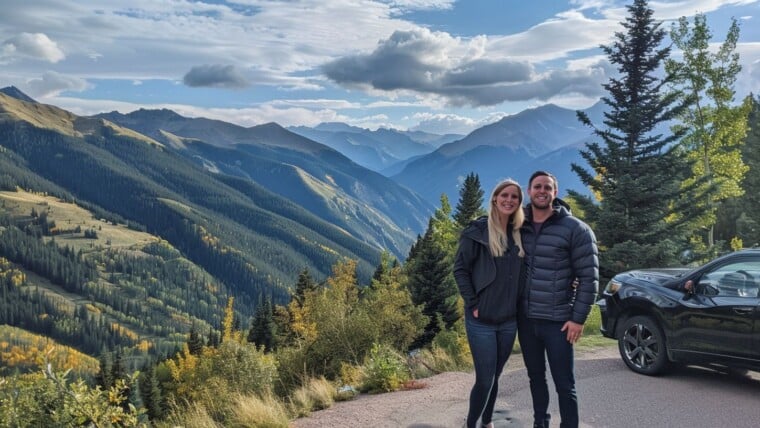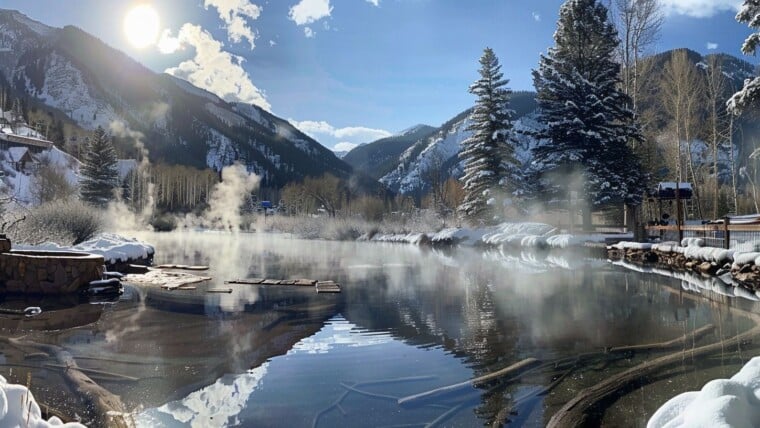Tucked away in the majestic Rocky Mountains, Vail is a gem that captures the essence of Alpine charm. Imagine stepping into a storybook village where every street and building tells a tale of adventurous pioneers and architectural wonder.
Many come to Vail seeking thrilling slopes but find themselves enchanted by its rich history and fairy-tale buildings.
Vail wasn’t always the bustling resort we know today. It started with a dream, rooted in the hearts of soldiers who skied the Alps during World War II. They envisioned bringing that European magic to Colorado’s rugged peaks – thus creating Vail.
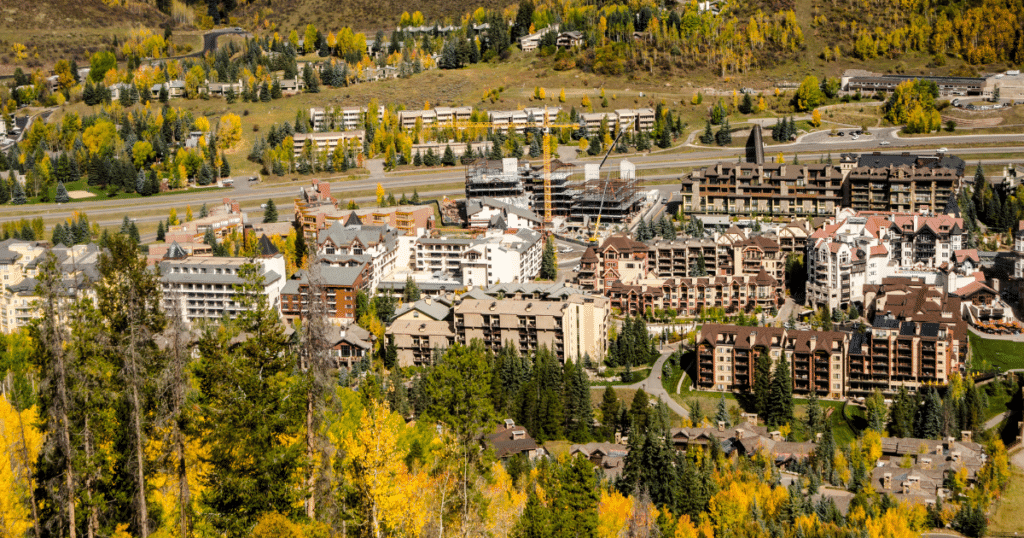
The Founding and Early Development of Vail
In the early 1960s, Vail was founded by Earl Eaton and Pete Seibert, who envisioned a world-class ski resort in the Colorado Rockies. The construction of Vail Ski Resort began in 1962, with infrastructure and accommodations rapidly following suit.
The visionaries behind Vail’s creation
Pete Seibert and Earl Eaton dreamt up Vail Mountain. They met in the 1950s and shared a love for skiing. Pete served in the 10th Mountain Division during World War II, where he trained at Camp Hale.
The rugged beauty of the Alps captured his imagination there. He wanted to bring that charm back home.
They scouted Western Colorado for perfect slopes. After checking out various places, they found magic on a mountain near Leadville and Glenwood Springs. This was it – their dream location! Their vision took shape as they planned lifts and trails that would become Vail Ski Resort.
Initial construction and development phases
Vail began as a dream shaped by the Alps. In the early 1960s, the founders started building a ski resort.
- Crews first broke ground in 1961. They worked hard in the rugged Colorado terrain.
- The resort opened with just one gondola, two chair lifts, and eight ski runs. It was all they had but enough to start.
- Vail Village’s layout took inspiration from European alpine towns. This design charmed visitors from the start.
- Builders used local timber and stone for construction. These materials gave Vail an authentic mountain feel.
- Pete Seibert and Earl Eaton led the planning. Their vision directed every road, building, and ski trail.
- Development focused on blending with nature. Every effort was made not to harm the beauty around them.
- Vail Associates managed construction projects. They ensured that everything followed Pete’s Alpine experiences.
- Skiers flocked to Vail after it opened December 15, 1962. Their visits helped grow this little town fast.
- The heart of Vail Village was built during these years. It quickly became a hub for travelers and skiers alike.
Vail’s Charming Tyrolean-style Architecture

Vail’s architecture is characterized by its charming Tyrolean-style, resembling the Alpine region of Austria. The buildings in Vail feature pitched roofs, decorative woodwork, and painted frescoes, adding to the town’s unique charm.
Characteristics of Tyrolean-style architecture
Vail’s Tyrolean-style buildings make the town unique. They reflect a “little Bavaria” in Colorado, just as the founders dreamed.
- Wood and stone are main materials, giving a rustic feel.
- Brightly colored facades catch your eye and charm you.
- Balconies often have intricate woodwork, perfect for mountain views.
- Peaked roofs handle heavy snowfall and add to the fairy – tale look.
- Traditional shutters decorate windows, contributing to the alpine vibe.
- Carvings and frescoes adorn exteriors, telling stories without words.
Unique features of Vail’s buildings
Vail’s buildings whisk you away to a Bavarian village without leaving Colorado. Tyrolean designs are everywhere, with spired roofs and vintage-style clocks catching your eye. Cozy shutters decorate windows, while warm wood and stone work together for an alpine touch.
These features come alive at The Arabelle at Vail Square where luxury meets traditional Austrian looks.
Step inside places like The Ritz Carlton in Bachelor Gulch and feel grandeur mixed with comfort. The chalet-style outside leads to lodge-like interiors that wrap you in modern elegance.
Fireplaces burn brightly here, making every room inviting after a day on the slopes.
Historic Buildings in Vail
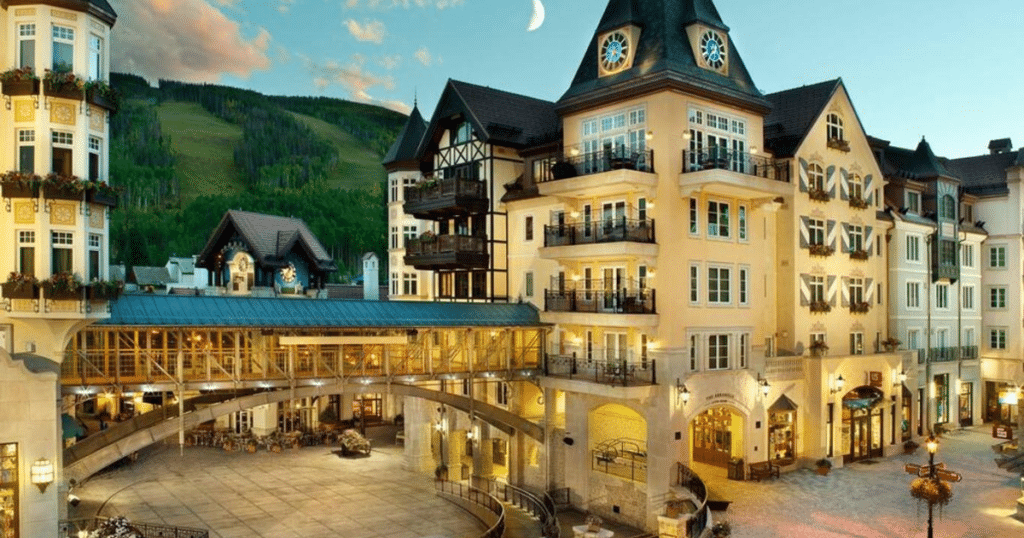
Explore the rich history of Vail through its iconic historic buildings, including the charming Gasthof Gramshammer, the cozy Sitzmark Lodge, the luxurious Sonnenalp Vail, and the elegant Tivoli Lodge.
Each building tells a unique story of Vail’s past and contributes to its vibrant cultural heritage.
Gasthof Gramshammer
Pepi and Sheika Gramshammer, in 1964, opened Gasthof Gramshammer, a family-run hotel that perfectly reflects their European roots. This charming establishment contributes significantly to the historic and architectural significance of Vail by offering modern amenities in the iconic Austrian style.
With its authentic Tyrolean architecture and warm hospitality, Gasthof Gramshammer provides visitors with a unique experience that captures the essence of Vail’s rich history and culture.
Maintaining its allure throughout the years, Gasthof Gramshammer remains an integral part of Vail’s legacy while preserving the town’s distinctive charm.
Sitzmark Lodge
The Sitzmark Lodge, purchased by Robert and Helen Fritch in 1974, offers personalized service and has expanded over the years to become a cozy retreat in the heart of Vail. With its charming Tyrolean-style architecture and warm ambiance, the lodge provides a comfortable haven for weary travelers.
Nestled amid Vail’s picturesque surroundings, it captures the essence of alpine living while providing easy access to the town’s vibrant dining and shopping scene.
Sonnenalp Vail

The Sonnenalp Vail, acquired by the Faessler family in 1979, stands as a historic cornerstone reflecting Vail’s charming Tyrolean-style architecture. Boasting lavish accommodations, ski concierge services, modern spa offerings, and fine dining opportunities – the hotel showcases the founders’ vision of creating a “little Bavaria” in Colorado.
The iconic Tyrolean-style buildings and luxurious amenities make it an integral part of Vail’s rich history and architecture, contributing to the unique atmosphere and charm of the town for visitors seeking an authentic alpine experience without leaving Colorado.
Reflecting their experiences in the Alps while serving in the 10th Mountain Division of the US Army, the founders brought this influence into Vail’s architecture and character with Sonnenalp Vail – ensuring it remains a testament to its roots whilst providing guests a glimpse into its early development connected to key historical events.
Tivoli Lodge
Located in Vail since 1967, Tivoli Lodge offers a picturesque mountain retreat for visitors. This family-owned lodge, still managed by the Lazier family today, features charming outdoor hot tubs and firepits.
Its prime slopeside location provides direct access to Gondola One, making it an ideal choice for avid skiers and snowboarders. Notably, the lodge boasts a chocolate Labrador mascot that adds warmth and hospitality to guests’ experiences.
Nestled in the heart of Vail, Tivoli Lodge combines rustic alpine charm with modern amenities for a cozy and inviting stay. With its rich history and stunning surroundings, this lodge is a quintessential part of Vail’s story and continues to be an essential destination for travelers seeking an authentic mountain getaway experience.
Vail’s Evolution: From Ski Resort to Vibrant Village
Vail Ski Resort has evolved from a simple ski area to a vibrant village with chic chalets and bustling villages, offering visitors much more than just world-class skiing. Read on to learn about the town’s rich history and architecture.
Expansion of Vail Ski Resort
Vail Ski Resort expanded its terrain and infrastructure, boasting over 5,300 acres of skiable area and building high-speed quads to enhance access. The resort continually invests in state-of-the-art facilities, such as the addition of new lifts and snowmaking technology to improve guest experience.
The expansion also introduced innovative dining options with a focus on French cuisine, elevating Vail’s culinary scene. Moreover, the implementation of the Epic Pass offers seamless access to nearby resorts like Beaver Creek, Keystone, Breckenridge, and more across Colorado.
Development of chic chalets and vibrant villages
Vail’s evolution from a ski resort to a vibrant village saw the development of chic chalets and colorful villages. The town’s architecture reflects the founders’ vision of creating a “little Bavaria” in Colorado, with charming Tyrolean-style buildings becoming iconic.
Vail Village began to emerge as the resort grew in popularity, attracting families and couples who opened family-run hotels, inns, and lodges.
Preserving Vail’s history while embracing modernity has been central to the town’s growth. Such balance between past and present keeps Vail an attractive destination for travelers seeking a mix of heritage and modern comfort.
Preserving Vail’s History: The Role of Local Families
Local families play a crucial role in preserving Vail’s history through the operation of family-run hotels and the contributions of elite athletes to the town’s legacy. Discover more about Vail’s rich history and architecture by delving into our blog!
Family-run hotels keeping Vail’s history alive
Family-run hotels in Vail have played a crucial role in preserving the town’s rich history, offering a glimpse into its early beginnings and maintaining its old-world charm.
- The Gasthof Gramshammer stands as a testament to this, with the Gramshammer family keeping the tradition alive since 1964. The hotel maintains its original Tyrolean-style architecture while providing modern amenities for guests.
- Robert and Helen Fritch’s ownership of the Sitzmark Lodge since 1974 has ensured personalized service and an expansion that still respects the lodge’s historic character.
- The Faessler family brought the Sonnenalp Resort of Bavaria to Vail in 1979, infusing the town with lavish accommodations and modern spa services while upholding its rich heritage.
- Bob and Dianne Lazier’s Tivoli Lodge, established in 1967, continues to be run by their family, attracting visitors with its combination of historic charm and contemporary comforts.
Vail’s elite athletes and their contribution to the town’s legacy
Elite athletes have left an indelible mark on Vail’s legacy, influencing its development and culture. Their athletic prowess brought attention to Vail and its potential as a world-class ski destination, attracting visitors from around the globe.
Additionally, their dedication to the town’s growth has contributed to the vibrant atmosphere that defines Vail today. These athletes have become integral figures in shaping Vail’s identity as a premier skiing and leisure destination.
The significant impact of elite athletes such as Pete Seibert on the founding of Vail ski resort reflects their enduring contribution to the town’s history. Their vision and determination have not only put Vail on the map but also inspired subsequent generations of outdoor enthusiasts to embrace this captivating alpine setting.
In conclusion, Vail’s founding by the visionary 10th Mountain Division soldiers shaped a unique Tyrolean-style architecture. The charm of Vail’s buildings reflects its founders’ dream of creating a little Bavaria in Colorado.
Historic landmarks like Gasthof Gramshammer and Sonnenalp Vail preserve the town’s rich heritage. From ski resort to vibrant village, Vail’s evolution continues to captivate visitors from all corners of the globe.
Embrace history and explore the enchanting architecture that makes Vail an unparalleled travel destination!
FAQs
1. Who founded the town of Vail and when?
Pete Seibert and Earl Eaton, along with other early settlers like Harley Higbie, founded the town of Vail in Colorado during the 1960s.
2. What makes Vail’s architecture special?
Vail is known for its charming Tyrolean-style architecture which makes you feel like you’re in a little European village, surrounded by beautiful mountains.
3. Are there any historic buildings I can see in Vail?
Yes, there are several historic buildings that showcase the Alpine style from when Vail was first developed; they stand out and tell stories about the past.
4. How did skiing shape Vail?
Skiing shaped everything about Vail – it started as a ski area thanks to Pete Seibert’s vision after he saw Loveland Basin Ski Area, leading to what we now know as an amazing downhill resort.
5. Has Vail always been a popular place for skiing?
Yes! Since opening in 1962 with just one gondola and two chair lifts, including a poma lift, it quickly grew into one of Colorado’s most loved ski areas with high speed quads straight off I-70.

